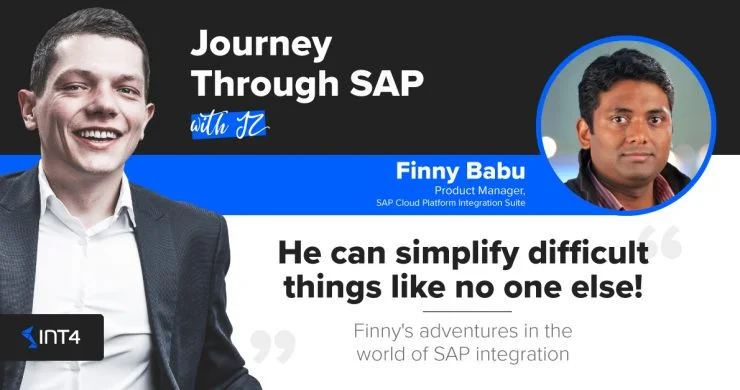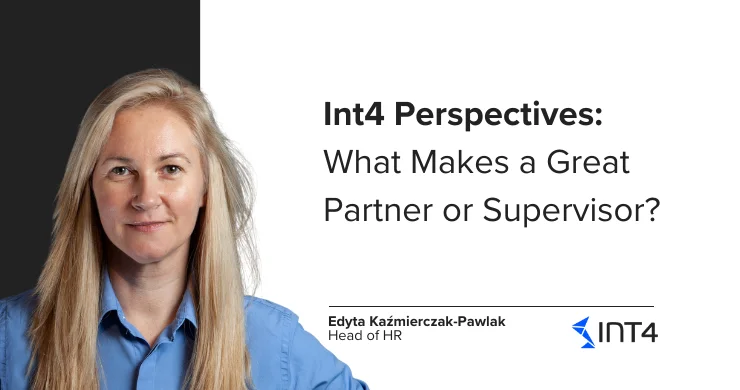He can simplify difficult things like no one else! Finny’s adventures in the world of SAP integration

Let me introduce my guest
My today’s interlocutor lives in Bangalore in India. He has spent almost 15 years in the IT industry, of which he has been working for SAP for 12 years, where he is currently the Product Manager for SAP Cloud Platform Integration Suite, focusing on simplifying integration. As he admits, the role enables him to engage with customers and support them in their integration journey via different channels. When he’s not dealing with SAP integrations, he loves spending time with his family. He is a happy husband and father of two daughters.
About the differences between Product Manager and Product Owner duties, working during the COVID-19 pandemic and challenges of integrating the Indian eInvoicing with CPI – Finny Babu is interviewed by Jarosław JZ Ziółkowski.
Reading time: 7 minutes
1. With respect to your role, how do you see the difference between a Product Manager and Product Owner, is there any?
It is a very good question and since I have played both the roles in my career at SAP, I can provide my thoughts on the differences. According to me, Product Manager has a deeper engagement with customers, supports them in the different phases of their projects, listens to their feedback and channels them back to the organization in the form of requirements. Product Manager is also responsible for the long term vision of the product and drives the roadmap accordingly. Whereas the Product Owner owns the user stories and backlogs derived out of the customer requirements in a scrum environment. The Product Owner drives the grooming to refine the requirements into meaningful user stories, creates mocks and is responsible to provide all necessary information for the scrum team to execute and deliver them efficiently.
I would say that both of these roles are important, and if they tag team, they can bring a lot of value to the customers and ultimately the organization.
2. We can see that you are a very active LinkedIn contributor, you have “liked” all SAP CPI certifications’ announcements – why do you use this platform?
LinkedIn is a great social media platform to “professionally” connect with the experts around the globe and I use this platform to learn, share and network with this expert community. There are so many cool things being developed at SAP, specially from the Integration side of the house, and I try my best to share these updates via all possible channels including LinkedIn & Twitter. We from the product management team run many enablement programs like the openSAP courses, Integration Black Belt series, monthly webinars, YouTube video series, and we feel very happy and get a sense of accomplishment when we see people participate in these programs and posting them on social media platforms.
3. Can you introduce SAP Cloud Platform Integration Suite and its functional usages which you would like to push for?
Absolutely! SAP Cloud Platform Integration Suite is a comprehensive Hybrid Integration Platform for the enterprise which covers both SAP and non-SAP integration. It is a versatile, dynamic and enterprise-grade integration platform-as-a-service which simplifies and accelerates enterprise integration and helps organizations to quickly transition to become intelligent enterprises. You can leverage the Integration Suite to simplify all your integration scenarios spanning across application-to-application integration (A2A), business-to-business integration (B2B), business-to-government integration (B2G), real-time API-based integration, non-SAP integration with 160+ out-of-the-box connectors, event based integration, and many more.
You can find more about it HERE.
We are working on improving the coherent usage of different capabilities of the Integration Suite, so that customers are able to get the best value out of them all at one place. Some of the first steps we took in this regard are simplified licensing, harmonized provisioning and I am happy to announce through your interview the availability of the Integration Suite trial. In addition, there will be many more aspects that we will bring, in the upcoming months to make this experience beautiful.
4. Do S/4HANA implementations impact SAP Cloud Platform Integration Suite usage in any way?
Yes, definitely in a very positive way. There are many customers who are using SAP Cloud Platform Integration Suite for their SAP S/4HANA integrations. This is driven by the fact that the Integration Suite provides a rich set of pre-packaged integration scenarios, APIs, business events and CDS views for SAP S/4HANA, which enables you to integrate it with other SAP Cloud, On premise or 3rd party applications. Based on the customer scenario whether it is cloud, hybrid or solely on prem, SAP Cloud Platform Integration Suite or SAP Process Orchestration can be leveraged for these integration scenarios. The recommendation would be to use Integration Suite (or CPI) for all cloud to cloud or hybrid integrations scenarios and for on-prem to on-prem integrations use PO. You can also leverage Open Connectors and use the 160+ out-of-the-box connectors to connect to 3rd party applications. The best part is that these pre-packaged integration scenarios shipped by SAP through the Integration Suite can also run on SAP Process Orchestration 7.50. You can save 10X cost & accelerate by 5X using pre-packaged business integration scenarios across SAP, Government & 3rd party applications.
5. What are the challenges of integrating the Indian eInvoicing with CPI? I assume that the implementation schedule must be tight and subject to legal aspects, anything else?
Digital Compliance or e-invoicing is a very complex process and requires organizations to adhere to country specific regulatory requirements. SAP provides an automated solution for digital compliance spanning across all involved software components. SAP Cloud Platform Integration Suite plays a major role in simplifying this process by providing pre-packaged integration content to integrate SAP with government organizations of different countries. Some of the examples of these pre-packaged e-invoicing integration content are:
- Electronic Invoicing for Italy, Columbia, Chile, Spain, Peru, Hungary, Mexico, Turkey
- VAT Register Books for Spain
- Electronic Transport Registration for Hungary
- Tax Integration for Germany – ELSTER
- Payroll e-Filing of Employees’ Payments and Deductions for United Kingdom
- SAP S/4HANA Statutory Reporting for United Kingdom Integration
- Tax Integration with SAP S/4HANA Cloud for USA by Vertex
- ERP Integration with GST Suvidha Provider for India
- Single Touch Payroll (STP) Reporting – Australia
- KATRE Incomes Register Integration Package
- New Zealand Inland Revenue Reporting for Payroll
Automated digital compliance by SAP solves a major part of the complex process by enabling integration of ERP systems with the government organizations, but there are still few challenges that exists for this overall process and some of them that I could think of are:
- Tight schedules enforced by the governments. For example, in India the process opened up on 1st February 2020 and the deadline was set to 1 April 2020. This created quite some rush but then later the government extended this deadline to October 2020.
- Frequent changes in the e-invoicing requirements, forcing organizations to quickly adapt to these changes.
- Modification or cancellation of e-invoices are difficult and need to follow strict guidelines
- Requirement of a separate archiving system, as many government sites store data for shorter duration
But I am sure all these challenges will be solved in a period of time, with more automation and extended support from government organizations.
6. What are the key trends and planned improvements for SAP Cloud Platform Integration Suite in the upcoming months/years?
Let me start with some of the recent innovations and then move on to the upcoming improvements. In the past couple of months, these were some of the significant improvements that were released
- Simplified licensing and harmonized provisioning of Integration Suite
- Integration Suite Trial
- FTP/FTPS Adapter
- Access policies to restrict access of individual monitoring artefacts
- Testing an integration flow from the designer, without the need of deployment
- Support for ZIP & TAR Splitter
- Client Certificate authentication support for Cloud Integration endpoints in API Management
- Custom Roles to be applied on Products in API Management
- Creating Custom Message Implementation Guidelines in Integration Advisor
You can also attend our monthly webinars, where we share the details of the latest enhancements released for the Integration Suite. What’s ahead of us?
Some of the planned upcoming improvements are:
- Integration Suite Launchpad, offering a single place to access all the capabilities of the Integration Suite
- Continuous investments in bringing feature parity between Cloud Foundry and Neo environments
- JDBC Adapter for on-prem and other cloud databases
- JSON Support in Mappings
- Access policies to restrict access of individual design artefacts
- Transport of integration flows
- Kafka Adapter
- Push mapping and validation artefacts from Integration Advisor to Cloud Integration
- Archiving support for B2B and B2G scenarios
- Smart discovery and consumption of APIs from SAP systems
- Low-code API development
- Additional B2B capabilities and Trading Partner Management
You can find more details on the upcoming improvements from the SAP Road Map explorer HERE.
7. How is the remote working due to COVID lockdown, affecting SAP projects that you are participating in?
At SAP, we always had this flexibility to work from home as and when required. Hence coping up with the lockdown and working from home was not difficult. As part of my product management role, I do support customers during the different phases of their implementation with enablement sessions, deal related discussions, supporting them during their go-lives, etc and all this is very much possible remotely, hence I would say there wasn’t any impact on these activities due to the lockdown, but yes I did had to make few adjustments on the personal front to support the family and kids at home.
8. I was wondering whether you liked recording the openSAP course and whether you would like to do it again?
It was my first experience creating and delivering the openSAP course Simplify Integration with SAP Cloud Platform Integration Suite along with an amazing team. Happy to share that as of today, there have been more than 16000 learners, who took this course. There is a lot of preparation that goes behind an openSAP course starting from selecting the right title, identifying the topics to be covered, dividing them into weeks based on growing level of knowledge, preparing the session content, assessment questions and at last the video recordings. The best part was the teaser video, which we wanted to make it very special and unique and the outcome was amazing. You should watch it. By the end of the whole process, we realized that product managers can also act. I thoroughly enjoyed the experience and would love to do it again.
Note from the author: If you want to learn more about CPI, for instance about Multiple iFlows with one destination – Check out my buddy Andrzej’s video.
I also strongly encourage you to check the first Video of my mate Konstantinos. In which he shed more light on SAP PI/PO API for Integration Directory Objects Maintenance
Find me via LinkedIn
Read also
1. ABAP stronger than chemical bonds! Amazing way from the lab to the SAP world with Daniel Mateo – interview with Daniel Mateo.
2. On Cloud around the world! Thoughts of a pundit straight from Walldorf – interview with Udo Paltzer.
Popular tags
ABAP int4 INT4 IFTT Int4Interview S/4HANA SAP AIF SAP CPI sap integration


